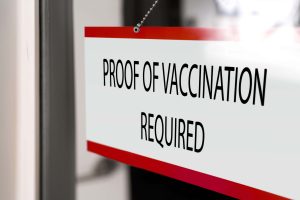Oklahoma Bar Journal
Vaccine Mandates and Their Role in the Workplace
By F.H. Hamidi
If before this year you did not know your neighbors, friends or coworkers’ stances on vaccines, you most certainly do now. And whether or not you previously had any interest in another person’s opinions on vaccine mandates, you are probably now interested. If you are an employer or counsel to an employer attempting to enforce a workplace vaccine mandate, you are likely concerned with the views of those who work in your industry on this topic. While the motive behind vaccine mandates is to create healthier working environments, the reality is that some employees will not take the vaccine and will instead retaliate by leaving their employers shorthanded or filing lawsuits against their places of work.

Maridav | #458645142 | stock.adobe.com
As the COVID-19 vaccine has been available to a portion of the adult population for a year now, we have seen enough instances of COVID-19 vaccine mandates by employers to assess the results of such mandates. This article will first offer an overview of the Biden administration’s requirements for implementing COVID-19 vaccine mandates, guidance for implementing vaccine mandates in the workplace and recognized exemptions to those mandates. The article will then highlight precedent for vaccine mandates before discussing employee responses to COVID-19 vaccine requirements.
MANY EMPLOYERS MUST NOW MANDATE COVID-19 VACCINATION FOR THEIR EMPLOYEES
On Sept. 9, 2021, President Biden issued an executive order mandating COVID-19 vaccinations for federal employees, subject to such exceptions as required by law.1 The order permitted the Safer Federal Workforce Task Force to publish guidance on vaccine mandates for federal employees and, later, similar guidance in response to an order mandating vaccination for federal contractors and subcontractors. Pursuant to the guidance, federal employees needed to be fully vaccinated by Nov. 22, 2021.2 Employees are deemed “ully vaccinated” two weeks after receiving the requisite number of doses of a COVID-19 vaccine approved or authorized for emergency use by the U.S. Food and Drug Administration (FDA).3 The task force answered frequently asked questions on its guidance page, noting that federal employees who work remotely are still subject to the requirement because those employees may still interact with the public as part of their job duties.4 As for federal contractors and subcontractors subject to a covered contract, they must conform to the following workplace safety protocols:
- COVID-19 vaccination of covered contractor employees [originally by December 8, 2021, and postponed to January 4, 2022], except in limited circumstances where an employee is legally entitled to an accommodation;
- Compliance by individuals, including covered contractor employees and visitors, with the Guidance related to masking and physical distancing while in covered contractor workplaces; and
- Designation by covered contractors of a person or persons to coordinate COVID-19 workplace safety efforts at covered contractor workplaces.5
The guidance also answers frequently asked questions. For instance, a recent antibody test or past COVID-19 infection cannot act as a substitute for COVID-19 vaccination, and the requirement for contractors and subcontractors to become vaccinated also applies to those who work in outdoor settings.6
Prior to these sweeping mandates, President Biden required nursing homes and, later, all health care facilities that accept federal funding to mandate vaccines for their employees, totaling an estimated 17 million workers.7The initial mandate on nursing homes receiving federal dollars was likely borne out of statistics from a Centers for Medicare & Medicaid Services (CMS) report concluding, “‘Nursing home’ beneficiaries accounted for just 2% (1.4 million) of the Medicare beneficiaries (62 million), but about 22% of all COVID-19 cases in the U.S.”8 Dr. Charles Crecelius, medical director for two St. Louis-area nursing homes, commented that the downward trend of COVID-19 cases and related deaths in his nursing homes became clear after 90% or more of the staff became vaccinated pursuant to the mandate.9 This small-scale observation is supported by researchers who found a striking correlation between an increased percentage of vaccinated staff and a decreased percentage of resident infection upon analyzing data from 500 Missouri nursing homes over a three-month period.10

Markus Mainka | #403698309 | stock.adobe.com
Pursuant to the U.S. Occupational Safety and Health Administration's (OSHA) emergency authority over workplace safety, President Biden later announced on Nov. 4, 2021, that he intended to enforce a COVID-19 vaccine mandate for private-sector businesses that employ 100 or more workers.11 American workers had until Jan. 4, 2022, to attain fully vaccinated status.12 Because the various rules for federal and private-sector employees only covered two-thirds of the United States workforce, OSHA opened up a 30-day public comment period on a rule expanding the private-sector mandate to cover businesses with fewer than 100 employees.13 OSHA is prepared to defend against lawsuits over the private-sector rule, and the administration is confident the rule is within OSHA’s emergency rulemaking authority.
EMPLOYERS SHOULD BECOME FAMILIAR WITH RECOGNIZED EXEMPTIONS
As many agencies and businesses have become subject to requirements mandating the COVID-19 vaccine for employees, employers should familiarize themselves with exceptions to the rule or “exemptions.” Employees may request exemptions to their employers’ COVID-19 vaccine mandate based on a sincerely held religious belief or a medical condition/disability covered by the Americans with Disabilities Act (ADA). Examples of such reasonable accommodations, as identified by the Equal Employment Opportunity Commission (EEOC), include requiring an unvaccinated employee entering the workplace to wear a face covering, work at a distance from others, work a shorter shift if around other people, submit to COVID-19 testing, work remotely or accept reassignment.14
The EEOC recently expanded its guidance on religious exemptions to employer vaccine mandates under Title VII of the Civil Rights Act of 1964.15 Generally, employees may request an exception, called a religious or reasonable accommodation, from an employer requirement, such as a requirement to receive vaccination, that conflicts with their sincerely held religious beliefs, practices or observances.16The granting or denying of such a request should be determined upon consideration of the particular facts of each employee’s situation. Only sincerely held religious beliefs, practices or observances qualify for religious-based accommodation.17 An employee does not need to use magic words to make a request, but the employee should communicate the existence of a conflict between their religious beliefs and a workplace COVID-19 vaccination requirement.18 The EEOC emphasizes that employers may inquire into the employee’s religious accommodation request on a limited basis by questioning either the religious nature of the employee’s belief or the sincerity of an employee’s stated beliefs.19 Uncommon religious practices can be recognized in accordance with the exemption as long as the belief is sincerely held.
Title VII does not require an employer to provide the accommodation in the event the employer is unable to reasonably accommodate an employee’s religious belief without “undue hardship.”20 The United States Supreme Court defined “undue hardship” in this situation as requiring an employer to bear more than a minimal or de minimis cost to accommodate an employee’s religious belief. Both financial costs and any burden on employer’s business practices, including, here, the risk of spreading COVID-19 to others, should be considered when determining the level of hardship an accommodation poses.
Persons covered by the ADA may request exemptions from their employer’s COVID-19 vaccination mandate based on medical conditions or disabilities that would prevent them from safely taking the vaccine.21 Those conditions may include:
- allergic reactions to the vaccine,
- pregnancy conditions,
- chronic illnesses and
- other disabilities as determined by an employee’s physician.
To validate those conditions that may warrant disability exemptions from a COVID-19 vaccination mandate, employers may obtain medical documentation from workers who request disability-related accommodations to the extent permitted by law.22 Potential questions the EEOC suggests employers ask of their employees when the need for accommodation is not obvious include 1) how the disability creates a limitation, 2) how the requested accommodation will effectively address the limitation, 3) whether another form of accommodation could effectively address the issue and 4) how a proposed accommodation will enable the employee to continue performing their fundamental job duties.23 Again, employers are not required to grant every accommodation request, and not all requests should be viewed in the same light. Confirming the need for accommodations should result from an open exchange of information between the employee and employer to ensure 1) requiring vaccination of a particular employee would cause more physical harm than benefit to the employee and 2) the employee is not needlessly creating a health hazard for others in their workplace by refusing to take the vaccine.
EMPLOYEE RESPONSES TO EMPLOYER MANDATES
Despite the United States Supreme Court’s long-held precedent on vaccine mandates dating back to 1905, employees and local governments are fighting back against the current mandates. For the most part, this resistance does not appear to stem from a desire to contract COVID-19 or from a fear of the vaccine’s formula but rather from a fear that mandates of this nature violate employee rights. In Jacobson v. Commonwealth of Massachusetts, Massachusetts citizens living in Cambridge in 1897 experienced a smallpox outbreak, resulting in a public health crisis.24 Inhabitants of the city who were not vaccinated against smallpox by a date certain were subject to fines for noncompliance with the public health mandate.25 Exemptions were limited to children under 21 years of age who presented a “certificate signed by a registered physician that they are unfit subjects for vaccination.”26 Mr. Jacobson, who was of age, could not prove the alleged danger of the smallpox vaccine in his argument to the court.27 The court upheld the fine, reasoning that any risk of injury from the carelessness in administering the vaccine, or even in a conceivable case without carelessness, was too small to be seriously weighed against the benefits of proper administration and use of the vaccine – those benefits being public health and safety.28
Fast-forward to Nov. 4, 2021: The state of Oklahoma filed a lawsuit against the federal government to stop its COVID-19 vaccination requirement for employers, claiming mandates as the federal government’s way of making “healthcare decisions” for Oklahomans as opposed to the government’s means of making a public health decision in response to an ongoing emergency.29 Also on Nov. 4, attorneys general and governors in 13 other Republican-led states30 declared they would file lawsuits in an effort to stop the mandate.31 Only time will tell how these lawsuits will play out in the courts. OSHA is confident in its authority to enact such emergency rules, and Supreme Court precedent favoring the public policy of public health and safety is on its side.
Before President Biden’s series of mandate announcements, a group of more than 100 health care workers in Texas filed suit against their employer, Houston Methodist Hospital, claiming that Houston Methodist’s vaccine requirement was unlawful.32 The lawsuit followed the health system’s announcement to its 26,000 employees in April 2021 that a COVID-19 vaccine was now a condition of continued employment, subject to medical and closely held religious belief exemptions.33 The plaintiffs requested a temporary restraining order from 1) the hospital’s vaccination mandate and 2) preventing termination of employees who refused to take the vaccine within the timeframe outlined by hospital policy.34 The court denied the plaintiffs’ request on June 12, 2021, reasoning that the policy did not involve coercion. Judge Lynn N. Hughes of the United States District Court of the Sothern District of Texas opined, “This is not coercion. Methodist is trying to do their business of saving lives without giving them the COVID-19 virus. It is a choice made to keep staff, patients, and their families safer. [Plaintiffs] can freely choose to accept or refuse a COVID-19 vaccine; however, if [they] refuse, [they] will simply need to work somewhere else.”35 Elaborating on the nature of an at-will employment relationship, Judge Hughes continued, noting, “If a worker refuses an assignment, changed office, earlier start time, or other directive, he may be properly fired. Every employment includes limits on the worker’s behavior in exchange for his remuneration. That is all part of the bargain.”36
Although the federal government is now responsible for many COVID-19 vaccine mandates currently in place within agencies and businesses, employers subject to the federal mandates who implemented mandates prior to those federal mandates may still face lawsuits like the one over which Judge Hughes presided in Texas. Nurses, grocery store workers and airline personnel alike have rallied around the idea that conditions of employment should not include taking a vaccine. Many have left their jobs in droves and sacrificed their livelihood in response to employer vaccine mandates. Counsel representing employers against such claims by employees should closely review their clients’ mandate policies and documentation of accommodation requests, approvals and denials in conjunction with guidance from the EEOC, Title VII and ADA to ensure compliance.
CONCLUSION
While vaccine mandates are not new in the United States, with the first such law enacted in 1809 mandating vaccination against smallpox, neither is vaccine hesitancy, as demonstrated in Jacobson. In the late 19th and early 20th centuries, science, technology and society all moved more slowly than we can fathom today. The last smallpox outbreak in the United States occurred in 1949, and it was not until 1980, after a centuries-long battle involving multiple generations, that the World Health Assembly declared smallpox eradicated.37With every other aspect of daily life expedited (e.g., from riding in horse-drawn carriages to now traveling on jet planes, and from waiting patiently on the arrival of telegraphs to now instantly transmitting writings via text message), we should expect scientific discovery and eradication of viruses to move just as rapidly as everything else in 2022. Scientists formulated the vaccine expeditiously, yes, but only because of the incredible resources at their disposal now as compared to the last pandemic that required emergency response 100 years earlier. COVID-19 vaccine mandates are a last resort after we collectively failed to voluntarily take the vaccine, failed to consistently wear face masks in public and failed to socially distance in those first weeks of the pandemic’s United States spread two years ago. The attention and resources our government and employers have allotted to preventing the spread of this deadly virus will be resources well spent if ours is the only generation to know a world with COVID-19.
 ABOUT THE AUTHOR
ABOUT THE AUTHOR
Fareshteh Hamidi is an associate at Sweet Law Firm in Oklahoma City, where she practices medical malpractice defense and general insurance defense. She is a proud 2019 graduate of the University of Tulsa College of Law.
- Exec. Order No. 14,043, 86 Fed. Reg 50989 (Sept. 14, 2021).
- COVID-19 Workplace Safety: Guidance for Federal Employees, Safer Federal Workforce Task Force (www.saferfederalworkforce.gov/faq/vaccinations) (last visited Nov. 4, 2021).
- Id.
- Id.
- COVID-19 Workplace Safety: Guidance for Federal Contractors and Subcontractors, Safer Federal Workforce Task Force (Sept. 24, 2021).
- Id.
- Anne Flaherty, “Vaccine or test: Biden advances sweeping new mandates for private sector,” ABC News (Nov. 3, 2021).
- Brian Higgins and Rhonda Schechter, “Nursing homes struggle to survive an employee vaccine mandate,” Reuters (Oct. 8, 2021).
- Annika Merrilees, “High Staff Vaccination Rates Helps Nursing Homes Beat COVID,” St. Louis Post-Dispatch (Sept. 18, 2021).
- Id.
- Nandita Bose, et al., “Biden sets COVID-19 vaccine rules for businesses,” Reuters (Nov. 4, 2021).
- Id.
- Id.
- What You Should Know About COVID-19 and the ADA, the Rehabilitation Act, and Other EEO Laws, Sec. K.2., U.S. Equal Employment Opportunity Commission (www.eeoc.gov/wysk/what-you-should-know-about-covid-19-and-ada-rehabilitation-act-and-other-eeo-laws#L) (last visited Nov. 4, 2021).
- Id. at Sec. L.
- Id.
- Id. at Sec. L.1.
- Id.
- What You Should Know About COVID-19 and the ADA, the Rehabilitation Act, and Other EEO Laws at Sec. L.1.
- 42 U.S.C. §2000e(j).
- What You Should Know About COVID-19 and the ADA, the Rehabilitation Act, and Other EEO Laws, Sec. L., U.S. Equal Employment Opportunity Commission (www.eeoc.gov/wysk/what-you-should-know-about-covid-19-and-ada-rehabilitation-act-and-other-eeo-laws#L) (last visited Nov. 4, 2021).
- Id. at Sec. D.6.
- Id.
- Jacobson v. Commonwealth of Massachusetts, 197 U.S. 11, 25 S.Ct. 358 (1905).
- Id. at 359.
- Id. at 358-359.
- Id.
- Id. at 360.
- Kaylee Douglas, “Oklahoma Attorney General files lawsuit against Biden administration over COVID-19 vaccine mandates,” KFOR (Nov. 4, 2021).
- Those other states include Alabama, Arizona, Arkansas, Florida, Idaho, Indiana, Iowa, Louisiana, Missouri, Montana, Nebraska, New Hampshire and South Dakota.
- Andrew DeMillo and Geoff Mulvihill, “GOP state officials push back on employer vaccine mandate,” Associated Press News (Nov. 4, 2021).
- Bridges v. Houston Methodist Hospital, No. 4:21-cv-01774, 2021 WL 2399994 (S.D. Tex. June 12, 2021).
- Id.
- Id.
- Id.
- Id.
- “Smallpox,” Centers for Disease Control and Prevention (www.cdc.gov/smallpox/index.html) (last visited Nov. 4, 2021).
Oklahoma Bar Journal – OBJ 93 Vol 2 (February 2022)
